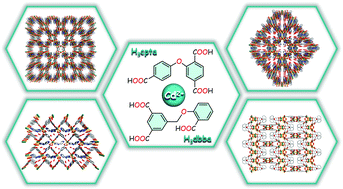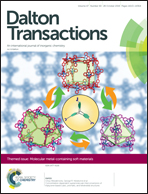A new series of Cd(ii) metal–organic architectures driven by soft ether-bridged tricarboxylate spacers: synthesis, structural and topological versatility, and photocatalytic properties†
Abstract
Two multifunctional, ether-bridged tricarboxylic acids, 2-(4-carboxylphenoxy)terephthalic acid (H3cpta) and 2-(3,5-dicarboxylatobenzyloxy)benzoic acid (H3dbba), were used as unexplored and highly versatile building blocks for the hydrothermal generation of a novel series of cadmium(II) metal–organic architectures. These were formulated as [Cd(μ-Hcpta)(phen)(py)]n (1), {[Cd3(μ5-cpta)2(phen)3]·8H2O}n (2), {[Cd3(μ5-cpta)2(2,2′-bipy)3]·6H2O}n (3), {[Cd(μ3-cpta)(Hbpa)]·2H2O}n (4), {[Cd6(μ4-cpta)2(μ6-cpta)2(H2biim)2(H2O)6]·5H2O}n (5), [Cd3(μ4-cpta)2(μ-prz)(H2O)4]n (6), {[Cd3(μ4-dbba)2(phen)3]·H2O}n (7), and {[Cd3(μ3-dbba)2(2,2′-bipy)3(H2O)3]·2H2O}n (8) on the basis of single-crystal X-ray diffraction, elemental analysis, FTIR, PXRD, and TGA data. Products 1–8 were assembled in the presence of N-donor crystallization mediators selected from pyridine (py), 1,10-phenanthroline (phen), 2,2′-bipyridine (2,2′-bipy), bis(4-pyridyl)amine (bpa), 2,2′-biimidazole (H2biim), or piperazine (prz). The nature of the crystallization mediator and/or the type of principal tricarboxylate building block have a significant effect on the structural diversity, dimensionality, and topology of the resulting cadmium-organic architectures. These span from 1D (1, 8) and 2D (7) coordination polymers to 3D metal–organic frameworks (2–6) with intricate topologies (3,4,5T64 in 2 and 3, utp (103)-d in 4, 3,4,4T9 in 6) that also include unprecedented types in 5 and 7. Besides, MOF 6 features a 3D + 3D two-fold interpenetrated framework. Luminescent and photocatalytic properties of selected materials were investigated, showing that coordination polymer 7 is a promising photocatalyst for the UV-light-driven degradation of methylene blue as a model organic dye pollutant. Moreover, products 7 and 8 are the first examples of structurally characterized coordination compounds derived from H3dbba.

- This article is part of the themed collection: Molecular metal-containing soft materials


 Please wait while we load your content...
Please wait while we load your content...